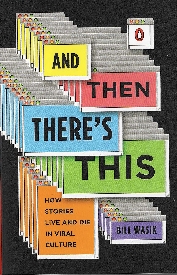University News
FYE Common Reading
May 26, 2011
MACOMB, IL -- Journalist Bill Wasik's book, "And Then There's This: How Stories Live and Die in Viral Culture" has been selected as the common reading for Western Illinois University's 2011-2012 First Year Experience (FYE) program.
According to Associate Provost for Graduate and Undergraduate Studies and FYE Coordinator Judi Dallinger, like past years' common readings, "And Then There's This" will be used as a starting point for the campuswide discussion of the 2011-2012 University theme, Science & Technology: Discover, Innovate, Create. The book is a required read for incoming freshmen and will be used as a link between other campus activities.
The University purchases the FYE book for all incoming students, and WIU's Leslie F. Malpass Library runs a resource webpage for the book and collects resources related to the reading so that students can complete relevant research projects.
Wasik, an editor at WIRED magazine, journeys to the edge of our churning and rambunctious viral culture to illuminate how anyone with a computer can initiate a small ripple of a story that can turn into a tsunami. While exploring this landscape, Wasik -- who organized the very first flash mob in 2003 -- examines other Internet sensations: the meteoric rise and fall of pop bands, guerrilla marketing, political blogs and more.
"I think this book will be interesting for our students because they have seen at least one of these concepts in the book in play, such as a flash mob, and I think that most faculty will be able to easily incorporate this book in their classrooms because, as the author notes, we live in a viral world," said Stacey Macchi, WIU communication professor and FYE instructor. "Wasick notes that keeping up with what is current is like a roller coaster, because what might be news today, or the high part of the coaster, comes down quickly only to be replaced with something even more sensational. Due to the nature of our rapidly changing media environment, the author becomes a viral culture experimentor."
Posted By: Darcie Shinberger (U-Communications@wiu.edu)
Office of University Communications & Marketing


Connect with us: